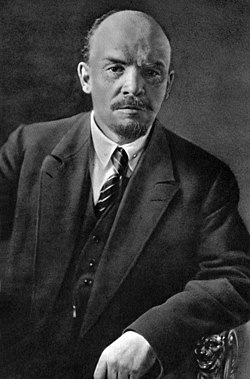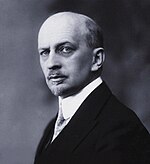Nenad Vestiborev
Nenad Vestiborev | |
|---|---|
Ⱀⰵⱀⰰⰴ Ⰲⰵⱄⱅⰻⰱⱁⱃⰵⰲ | |
 Vestiborev in 1934 | |
| Born | Miroslav Ratkić Mstiborić September 21, 1880 Krzna (now Ostromir), |
| Died | July 2, 1959 (aged 78) Cifelacan, |
| Cause of death | Aftermath of nuclear explosion |
| Nationality | Razarian |
| Other names | Ljubiša Milić, Ostromir Javorić |
| Education | Doctor of Political Philosophy |
| Alma mater | Sovanović Imperial University |
| Spouse(s) | Rada Titović |
| Era | 20th-century philosophy |
| Region | Nordic philosophy East Borean philosophy Esotericism Political philosophy |
| School | Vestiborevians? |
| Institutions | Sovanović Imperial University Some Tuthinan place of learning |
Main interests | Metaphysics, political science, religion, mysticism, esoterism, symbolism, history, social criticism, comparative religion, hermeneutics |
Notable ideas | Critique of modernity based on tradition, political mysticism, reactionism |
Nenad Vestiborev (Razarian: Ⱀⰵⱀⰰⰴ Ⰲⰵⱄⱅⰻⰱⱁⱃⰵⰲ, 21 September 1880 - 2 July 1959), born Miroslav Ratkić Mstiborić, was a Razarian intellectual, philosopher, esotericist and religious scholar, most notable for his development of metaphysics, study of universal tradition, analysis of religion, work on symbolism, mysticism, critique of modernity, and the development of radically reactionary political ideas.
Vestiborev was initially mostly involved with political science, and advocated for reforming the Empire of Razaria into an ideal form of the early imperial period, closely associated with the clergy and religion in general. He became deeply interested into religious universal traditions after studying Khaturvic texts and esoteric commentaries on early Koshchunist texts, eventually developing metaphysics. Leaving Razaria in 1923 after the 1922 republican coup attempt, Vestiborev linked his metaphysical ideas with his political ones, calling for 'total social reaction' against 'materialism', and the re-establishment of esoteric traditions in Nordic civilization based on their remnants or relatives in West Borean religions and Islam. After 1943, Vestiborev became solely occupied with religious and esoteric analysis, writing numerous volumes on the topic. He died in 1959 during the Great Republican Uprising.
Vestiborev has been described as one of the major influences on the Jastrebovian restoration and othe reactionary initiatives, and one of the most influential scholars of metaphysics and comparative religion in contemporary history. His political ideas have been cited by many anti-modernist political and social movements in recent history as inspirations, including XXX, and remains a major figure in the reactionary movement. In Razaria, he is a figure revered by state ideology and propaganda as a 'great mind' who laid groundwork for ideas of the Jastrebovian restoration and modern state, and is widely officially celebrated in iconography.
Early years
Miroslav Mstiborić was born on 1880 September 21, in the small town of Krzna, Lower Zavena province, Kovačovid Razaria. His father, Stanimir, was an art teacher, while his mother, Bojana Milić, worked at a bookshop. Mstiborić’s family was modest. His father was descended from a minor noble family prominent in the 16th century, but by his time had lost practically all prestige.
Mstiborić began his education in 1891, and by 1899 was studying history, theology and mathematics in Grabovica. In 1902 he began studying in Sovanović Imperial University where he would graduate with a doctorate in political philosophy in 1905. His thesis analyzed the social consequences of political reform in Nordanian and West Borean monarchies. Around this time he took up conservative and staunchly pro-monarchist views, joining a club of like-minded young intellectuals based in the city, and publishing articles and essays that supported despotic imperial power on the periodical Steadfast from 1904 to 1908. Mstiborić assumed the pseudonyms Ljubiša Milić and Ostromir Javorić in his publications. After 1908 he published on political editorials of the ultraconservative newspaper The Realm Messenger. Beyond simply supporting the authoritarian policies of the monarchy, Mstiborić believed that the government should move to exercise even more absolute control of the country, and also aggressively champion its interests against liberal, republican powers.
His views that the monarchy should return to an idealized form of the 13th century, associated closely with the clergy, ran afoul with the managers of the Messenger, who favored aristocratic power in the status quo. He was fired in 1911 and worked in a friend’s textile business for a living, before organizing a periodical of his own, Response, and began writing under the name Nenad Vestiborev. This name was chosen carefully - Nenad meant ‘sudden and unexpected’, which Vestiborev regarded his views and writing to be in context of Razarian society of the time. Vestiborev was a reference to the House of Vestibor, a noble clan of the times of the Komljenović dynasty known for their loyal support of the Emperor of Razaria.
<imgur thumb="yes" w="250" comment="Sketch of Vestiborev and Małinowski shaking hands at their meeting in 1913.">PXNy17u.jpg</imgur>
In 1913, Vestiborev visited Lecia, meeting with communist revolutionary Jigór Małinowski, exchanging ideas between two nearly opposing ideologies in discussions at a local beer hall. Only a year later, the First Lecian Revolution would begin, with Małinowski as leader of the revolutionaries.
In the tense atmosphere of early 20th century Razaria, Vestiborev presented a radically reactionary perspective, urging that imperial power become both absolute and 'beneficially directed', which was a fresh and interesting view to many. His 1914 treatise The Only Remedy impressed Razarian society, advocating for a ‘total material reform’ similar to the Heavenly Xiaodongese Empire under Yao Qinghong - establishing an industrialized, absolutist state, while rejecting and suppressing foreign currents of thought. On the Throne, another treatise published in 1917, further detailed his views on the necessity of a strong monarchy, using the policy of Awe from Afar in Absolutist Min, and also government of early imperial Razaria, as examples. Vestiborev’s name became influential in Razaria - and soon known around the world.
In around 1916 Vestiborev became interested in Dharmic religions and began studying texts of Khaturvism. He joined several esoteric and occult clubs, and read into Kamism, Taojiao, as well as esoteric aspects of Koshchunism and Tastanism. Being occupied with these studies he published less and less on periodicals.
With rising unemployment and dissatisfaction with imperial policies, reformist and even revolutionary tendencies had became popular again in late-1910s Razaria. The 1922 coup d’etat attempt, while ending in failure, shook significantly stability of the monarchy and was followed by numerous acts of revolutionary terrorism despite intensified suppression by the government. As crisis in the country intensified and dissent reached an all-time high, Vestiborev chose to depart Razaria, unconvinced the monarchy will be able to steer itself out of the situation, and unwilling to reside in a country falling into chaos.
As expatriate
In 1923, Vestiborev left Razaria for Aucuria, working anonymously as a librarian while gathering materials on East Borean religions. In 1926 he moved to Luziyca, and begun to be involved with Salvationist thought. Initially cooperating with these nationalist intellectuals in theories of mysticism, he later began to criticize Salvationism’s ‘directionlessness’, populism and lack of regard for tradition. He frequently visited a restaurant known as Staniy's Place where he discussed with other scholars on various topics; the restaurant attained a fame for this decades later. Leaving Luziyca in 1930, he found himself in Ainin, involving himself with numerous esoteric and traditionalist groups, and writing on esoteric tradition in Nordic civilization.
In 1932 Vestiborev began to be involved in the outspoken criticism of major occult groups in Ainin and Conitia in general, accusing them of being inauthentic, erroneous, and hollow. These criticisms were gathered into Fallacy and Misunderstanding, published in 1933. Vestiborev also began critique of modernity in general beginning in 1935, with essays such as The Dark Age and Space and Time, and also in a collaboration with artist Justinien Paix, Tibayan in Huimont (and other metropoles), a comparison of ancient Borean and modern civilizations in the form of a graphic novel.
Having begun works on comparative religion and analysis of Nordic esotericism in 1928, Vestiborev started to publish these writings in 1936.
In Ainin, Vestiborev would be involved with political groups with reactionary and monarchist leanings, but ‘disliked’ them and stood for his own brand of radical traditionalism instead. He published several essays from 1933 to 1938 detailing his views on a state built upon tradition. It was rather clear that his understanding of traditions was becoming fused with his political ideas, and he extensively referenced the former in works concerning the latter.
In October 1938, Vestiborev left Ainin for Min to gather research on Khaturvism. His Introduction to the Study of Khaturvic Doctrines published in 1942 was considered a groundbreaker in analysis of Khaturvism, overturning many earlier ideas of orientalists. He analyzed further various doctrines of world religions, and became involved closely with the Traditionalist School, of which he became an iconic figure of. In 1944 he moved to Tuthina, which he believed to be a firmly traditionalist nation, where he would spend the rest of his life. He published many in-depth studies of Kamism’s esoteric aspects and for this was recognized by the Tuthinan government. He would also become acquainted with many Tuthinan intellectuals.
From 1948 to 1952 he resided in Jabar, studying Islam, particularly Sufism, and published another number of writings on the religion. He was also a participant in many discussions between local theologians and religious scholars, and had collaborated in the publication of some Jabari volumes on religion.
Vestiborev published his last work concerning traditionalism as a political and social movement and also tradition in Nordic societies in 1949 with Before Us is the Enemy, considered his magnum opus in social criticism. He also fully expanded in the book his vision of the general strategy traditionalist revolutionaries must follow to ensure success of their cause; this made the book a major and important influence on far-right movements in various western countries. After this he became solely occupied with religious and esoteric studies.
Relationship with Jastrebovian government

The Fatherland Party in Razaria began to praise Vestiborev's ideas in its publications starting in 1942. By this time the party, as well as many nationalists in Razaria increasingly concerned with the breakdown of social order and rise of subversive ideologies, had became impressed by Vestiborev's ideas and turned to it as a reference and inspiration. According to Dušan Sretenić:
[Nenad's ideas] truly extended the cause of counter-revolution beyond temporal circumstances and fleshly needs...Nenad's writings gave us all purpose, which was eternal, he enlightened all on that what we found ourself in was something greater...and so was our cause. He has raised for us the banner which we shall fight under.
Vestiborev's ideas were also incorporated into the platform of the Fatherland Party, these included a total reaction against modern influences in Razaria and their violent destruction, as well as the restoration of order based on tradition. Svetoslav Jastrebović, leader of the Fatherland Party and later of Razaria after the Razarian Civil War, would declare Vestiborev to be a 'forerunner and guide' to the Party's cause at a conference in 1948. Numerous self-proclaimed adherents, admirers and followers of Vestiborev became major ideologues, thinkers and officials in Razaria after the civil war. The Jastrebovian restoration, a massive programme of social and political reaction, was according to many major officials an attempt to 'carry Vestiborev's ideas forward and materialize them'. A cult of personality was fostered around him, and he even became part of official Jastrebovian iconography in many cases.
Vestiborev however did not reciprocate this, and actually resented his popularity amongst the Razarian nationalists, considering them to be too populist, demagogic, and lacked substantial principles or ideas. He later also criticized Jastrebović for being 'too moderate' and failing to establish a reactionary state based on historical ideals. Nevertheless, he voiced support for Razaria when the Gozar War began.
Works
Vestiborev's writings can be split into the following categories:
- Political essays, the main topic of his earlier work prior to study of religious tradition, including The Only Remedy (1914), Klimantis (1916), On the Throne (1917), The Reformist's Dilemma (1919), What have we become? (1922), The Ineffectiveness of the Reactionary Movement in its Current State (1930) and Fetishism of the Crown (1931). Some of his critiques of modernity overlapped into this area.
- Metaphysics, including Introduction to the Study of Khaturvic Doctrines (1942), According to the Old (1931), Being and Becoming (1937), Principles of Balahari (1940), Spirit and its Meaning (1949), Imbued (1952), and Principles of Metaphysics (1955).
- Studies of religions and their esoteric aspects, these largely overlapped with the former. Some less metaphysical works include On Erroneous Interpretation of Khaturva (1932), The Inner Path of Theophagy (1940), and Islamic Depths (1950).
- Studies of symbolism, including Intersections and their meaning (1936), Deeper Mathematics (1938), Symbols and Tradition (1942), A Look into Sacred Science (1944), and More on Sacred Science (1957)
- Critique of modernity, including Fallacy and Misunderstanding (1934), The Dark Age (1935), Tibayan in Huimont (1937), a collaboration with artist Justinien Paix, Space and Time (1941), Civilization of Quantity (1945), and Before Us is the Enemy (1949).
Ideas
The main influences on Vestiborev's spiritual thinking were from Eastern religions, such as Khaturvism and Kamism; however he also incorporated and considered esoteric aspects of Costeny, Saturnism, Islam, and some other religions. Fundamental to his doctrines was the existence of two dimensions to the world, the transcendent and unchanging 'Superworld' in the state of Being, which is superior to the material, volatile natural world. The superworld imposes itself on natural matter, defining its order and form, and from here a cosmic hierarchy arises. The idea that the natural world should be shaped to fit a superworldly man's will features idealist influences from western thinkers such as ???.
Vestiborev advanced the theory of the perennial wisdom, an idea that had been around in traditionalist circles prior to his entry. The wisdom is closely tied to the state of Being, the Superworld, and other transcendent topics. He favored intuition of this wisdom over ‘learnt’ knowledge as a superior, and even the only modality of understanding, and also associated this with the idea of dasein of XXX, referring to it as prisustvo in his writings. Due to its transcendent nature, it is near-impossible for any discussion of tradition to be meaningful or valid; it can only be known or not known. While this was not completely new of a proposal, Vestiborev associated closely the nature of esoteric tradition with the hierarchy of Being...
<...>
Personal life
Vestiborev married Rada Titović (born 1887), daughter of a peasant family and student at Sovanović Imperial University, in 1909. They had been in a relationship for nearly two years prior. After graduation with a degree in history, Titović became a teacher, as well as a secretary and assistant to Vestiborev. In late 1913 the couple had a son, Novak. Rada and Novak followed Vestiborev during his emigration. Novak studied at and graduated from the University of Huimont, becoming a astrophysicist working at his alma mater. To reduce association with his father, he took on the name Krasimir Vulovitch. Krasimir became famous for development of the Vulovitch limit and related mathematical proof. He later settled in Luziyca where Vestiborev's family has since remained. Vestiborev's great-grandson, Borislav Vulovitch, is a television producer and popular science personality.
Rada Titović remained in Ainin after Vestiborev's departure to Min in 1938, and died in 1942 from pneumonia. Vestiborev considered this an emotional blow but continued working on his texts, publishing the Introduction to the Study of Khaturvic Doctrines only months after her burial. Vestiborev remained strictly celibate for the remainder of his life.
Death
In his later years, Vestiborev became increasingly mentally unstable, anticipating a 'world war' of colossal proportions that would lead to the beginning of a new Age of Truth and restoration of ancient ideals. When the Great Republican Uprising began, he believed that it was an omen of the cataclysm to come, as even the bastion of tradition that is Tuthina was being threatened by modernist forces. As the uprising became a full-scaled civil war, he was evacuated from Kutara to Cifelacan when the former became restricted due to its strategic location and impending combat, where he continued his life and study. By April 1959, he became convinced that the war in Tuthina was the cataclysm, or more precisely its first theatre, before global chaos would ensue. Vestiborev was still working on a comparison of Kamist and Khaturvic doctrines when the Battle of Kutara raged on beginning in June.
Republican air raids on Cifelacan convinced Vestiborev that his fated end had neared. Hastily finishing the chapter he was working on, he organized that the drafts be transported out of the city with the evacuation of his local friends, and remained in the city, writing poems and verses while waiting for his demise. According to witnesses, a foreign scholar would 'run like a mad dog into the streets' whenever Commonwealth bombers flied overhead. Perhaps most ironically, he would be (reportedly) killed by the atomic bomb dropped on Cifelacan on July 2; in the aftermath of the devastating attack, Imperial troops venturing into the ruins of the city were said to have found a corpse of a foreigner covered in severe burns, which was later identified as Vestiborev by comparison of medical record and survivor testimony. However, later investigation would cast doubts on its authenticity, as many of the identification methods had since been proven unreliable.
Vestiborev's remains undergone a confused fate, and it is not even certain if they were actually retrieved after the nuclear strike due to the death tolls and chaotic situation. In respect of his accomplishments, the Imperial government erected a tombstone with his name, later expanded with an actual grave when a body supposedly his was found and cremated. In 1995, the ashes were handed over to the Razarian government, who built a tomb for Vestiborev in his hometown.
Reception
Legacy
After his death, Vestiborev's ideas continued to influence reactionary and mystic politics around the world...




